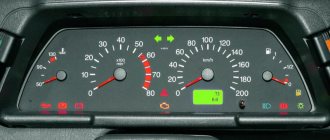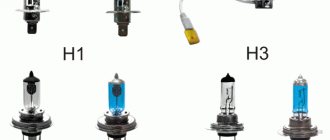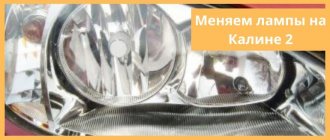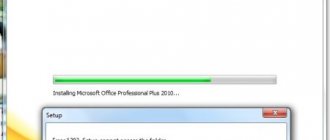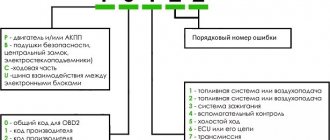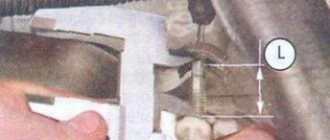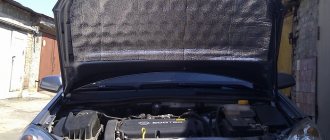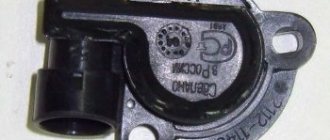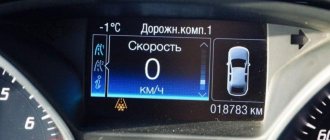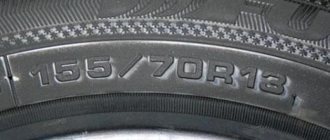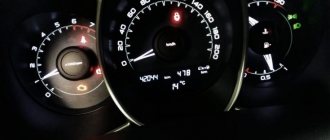Diagnostic process
Toolbar that can be used for diagnostics
So, diagnostic measures using the dashboard are not complicated, and almost every owner of a Kalina car can handle them on their own. By following the step-by-step instructions below, you can carry out diagnostics on each generation of the VAZ 1117-1119 car.
Now let's move directly to the process of performing diagnostic operations:
- Reset the trip mileage indicator. There is a button on the instrument cluster for this.
- While holding the button, turn it to position I. Insert the key into the ignition and turn it to position 1.
- If everything was done correctly, all arrows on the instrument cluster begin to move from the initial positions (zero values) to the final positions.
- Switch the information display using the button on the windshield wiper stalk.
- The first screen to check is the tachometer and gauges.
- In the latter case, the software version will be displayed on the screen. Often the software version (in this case UEr 3.0 or 3.2) is displayed on the control panel screen.
- In the third case, you will see error codes that are present in the ECU. There are 8 and 4 errors in photo 6.
- Now let's decipher the errors that may appear on the toolbar screen:
The daily trip button is used to reset the indicator.
Insert the key into the ignition and turn it to position 1.
The group of instruments rotates from the initial control point to the final control point.
The software version (in this case UEr 3.0) is displayed on the dashboard screen.
Errors received during diagnostics. There are 8 and 4 errors in photo 6.
Decoding instrument panel readings
- 2 — the on-board network voltage exceeds the norm;
- 3 - fuel level sensor error detected. Appears when the sensor circuit is broken within 20 seconds.
- 4 - coolant temperature sensor error. Appears if an open circuit is detected within 30 seconds.
- 5 - An outside temperature sensor error has been detected in the vehicle. appears when there is no sensor reading for 20 seconds);
- 6 - detection;
- 7 - incorrect oil pressure;
- 8 - error or malfunction of the brake system;
- 9 — low battery level;
- E- error detection in the data packet stored in the EEPROM.
Now all that remains is to compare all the errors that popped up on the screen with those indicated above.
As practice shows, diagnosing Lada Kalina using the dashboard is quite easy and simple. This does not require any special tools or skills. It is worth noting that, according to the experience of many car owners, it is not always possible to fully diagnose everything, because wear and breakage of some contacts can be interpreted by the ECU in its own way.
Cold engine won't start
If your car's engine does not start, you should know that this is due to reasons related to the temperature conditions of the device. This factor is stabilized quite simply and painlessly, and accordingly, weak points are easily eliminated.
First of all, the car may not start due to a cold engine that stubbornly refuses to warm up. As a rule, such a breakdown occurs during a long period of inactivity in the summer. In winter, everything happens much faster, because the temperature outside is minus.
Cross section of a 1.6i engine: 1 — oil pan drain plug; 2 — engine sump; 3 - crankshaft; 4 — oil filter; 5 - catalytic manifold; 6 — coolant pump; 7 - piston; 8 — oxygen concentration sensor; 9 — laying of the intake pipeline and exhaust manifold; 10 — inlet pipeline; 11 — nozzle; 12 — diagnostic fitting of the fuel rail; 13 - receiver; 14 — bracket for fastening the tip of the cable sheath; 15 — cylinder head cover; 16 — camshaft bearing housing; 17 - camshaft; 18 — crankcase ventilation system hose; 19 — valve pusher; 20 — cylinder head; 21 — bolt securing the head to the cylinder block; 22 - valve; 23 - candle; 24 — cylinder head gasket; 25 — upper compression ring; 26 — lower compression ring; 27 — oil scraper ring; 28 — piston pin; 29 — fitting for installing the oil level indicator; 30 — connecting rod; 31 - flywheel; 32 — cylinder block; 33 — oil pan gasket; 34 — oil level indicator; 35 - oil intake
In particular, the engine oil temperature is compared with the ambient temperature, which should not be the case. The weak points in this case are the coolants. The algorithm of actions for a cold engine is as follows.
- Pull the handle that controls the lock drive towards you, thus opening the hood.
- Take an oil dipstick and check the fluid level in the engine. You should know that ideally the mark should be between o and “MIN”.
- Check the engine cooling fluid level. Ideally it is half the capacity.
- Carefully inspect the engine and the space under the hood. Often the problems lie there. Particular attention should be paid to gasoline and oil drips, as well as brake and cooling fluid leaks. Be sure to check the integrity of the electrical wiring.
- Car malfunctions are more accurately identified when trying to start it, so without closing the hood, you need to get behind the wheel. If it’s raining or snowing outside, it’s best to cover the hood. Before this, you need to check the high-voltage wires on the spark plug coils, since very often faults lie precisely in them. Then you can turn on the ignition, having previously installed the key in it under the number “I”. This factor should lead to the operation of the device for supplying gasoline to the engine.
- The ignition key is turned and the car engine starts. If the attempt is unsuccessful, then the fault lies deeper. In particular, in the starting system, ignition system or engine power supply. In any case, you need to check all options. The video shows all the manipulations. You can watch a video on this problem.
What does error 4 mean?
Trouble code 4 indicates that the refrigerant temperature control controller is not operating properly. In most cases, this code lights up on the instrument panel when a break in the regulator wiring is detected, lasting 20-30 seconds.
- After analyzing your problem, we consulted many sources on the Internet and consulted with Lad Kalin owners. As it turns out, the number 4 often appears on the dashboard; this can be considered one of the most common errors on these cars. Replacing the antifreeze thermostat in the cooling system in some cases will help the product get rid of the error. However, according to most Kalina owners, in fact, in most cases this does not give a good result.
- If you believe the opinion of car owners, such an error, as a rule, occurs mainly in cold weather. If there are no prerequisites for refusal, then there is nothing to worry about.
- It is likely that the sensor itself has oxidized during the operation of the vehicle. As a result, poor contact is formed, which does not allow normal signal transmission. Sometimes this happens after the car has been washed. We recommend visual diagnostics of the controller - if you notice that the contact has actually oxidized, it should be cleaned.
- If cleaning contacts does not help, you need to start the dialer. It is possible that the reason for the code appearing on the instrument panel is a broken wire or short circuit. In the event of a wire break, it is enough to replace the wires or eliminate the cause of the short circuit.
If you have replaced the sensor, cleaned the contacts, but the problem has not disappeared, we recommend conducting more detailed computer diagnostics. On domestic cars, it often happens that when the control unit fails, errors may appear on the screen that actually do not exist. To figure this out, you need to read all the codes from the on-board computer and then draw conclusions.
Getting ready to replace the resonator
After some time of operation, every owner of a practical Lada Kalina is faced with the need to replace components of the exhaust circuit; a resonator needs to be replaced, and less often, a muffler needs to be replaced. Of course, no one has canceled the option of performing the repair procedure in a car service center, but the resonator is one of those products that are available for manual replacement.
To perform the entire list of repair operations, the owner does not need to use special tools and devices.
It will be enough to acquire:
- WD-40 penetrating agent, required for treating corroding joint areas of the resonator and its fasteners;
- a pair of keys of identical standard size (on “13”), only one of them will need a socket, and as the second you need to use a head complete with a wrench;
- with a hammer.
The main reason prompting the owner of a Lada Kalina to start replacing the resonator is progressive corrosion. Here it will be necessary to replace not only the exhaust system component itself, but also its fasteners (clamps), since they are also subject to intense corrosion and oxidation due to their location.
It is also recommended to replace the rubber suspensions of the resonator to the body, since over time they harden and crack, and therefore, gusts are possible and the exhaust system stops working.
Replacing the front brake pads of Lada Granta
DIY car diagnostics Kalina
According to the service manual, error No. 4 in the control unit indicates a malfunction of the coolant temperature sensor. According to our community members and drivers, this error is quite common and often occurs in Lada Kalina. You must understand why these errors occur and how to resolve them.
Error 4 appears in the ECU for several reasons. Let's consider all possible options:
All these reasons are quite easy to eliminate and do not cause serious concern.
How to view errors on the on-board computer?
The video shows the “self-diagnosis mode” of the Lada Kalina car, in which you can find out if there are errors:
Elimination methods
In order to eliminate the cause of error 4 in the Kalina ECU, you should do the following:
- Check the operation of the sensor. If it's dead, replace it.
- Check contact and absence of plaque. Clean the seat and replace the sensor.
- Check the on-board circuit and make sure there is contact.
- But a random error can only be cured by flashing the ECU and resetting all errors. To do this, you should contact a car service.
So the problem can be solved on your own, but practice shows that this is not always possible. Errors 4 are often enough to pop up in the cold season, when the car is parked on the street for a long time, and not in the garage.
Engines, consumption and transmissions of Lada Kalina II
Compared to the first generation, the second Lada Kalina has a seriously upgraded range of engines, which have finally increased in power to 100 hp. With. Engines consume 7-7.2 liters in the combined cycle.
The apogee of innovation was the automatic transmission. In 2012, the Jatco automatic made its debut on the related Lada Granta, and in 2013 it migrated to Lada Kalina hatchbacks and station wagons. Judging by the reviews, it was a very simple, hopelessly outdated 4-band automatic transmission without the ability to change gears manually. However, how was it? Jatco is the most alive and is still installed on all Kalinas, which are now Granta, and on Datsun co-platform models - on-Do and mi-Do.
In 2014, two significant events took place in the life of Kalina. They were fitted with a new VAZ AMT transmission - a “robot” with one clutch, created in collaboration with the German ZF and Porsche Engineering. And two special versions appeared - Kalina Sport and Kalina Cross. The fate of events is different. “Robot” did not catch on, and even in the best years, the share of sales of such machines did not reach 30% of the total volume. This is understandable: few people want to jerk instead of drive. And the Togliatti AMT, even after a series of upgrades, continued to drive incomprehensibly, thoughtfully, with jerks and bumps, and even after replacing clutches after thousands of 30 runs.
Also read: Nissan AD II - hellish apparatus or universal soldier
conclusions
It turned out that finding and eliminating the cause of error 4 in Lada Kalina is quite simple. Although deciphering error codes requires specialized knowledge, you can find the necessary information in this article.
The Lada Kalina car is equipped with an on-board computer that allows you to quickly diagnose any problems that may arise. Thanks to the control unit, you can find out about car breakdowns thanks to the read codes. In this article we will tell you what the most common Kalina error codes are and how to diagnose it yourself.
Interior
The interior of the first generation Lada Kalina, although somewhat improved compared to its predecessors, is still frankly outdated, losing to its main competitors, including budget Europeans and Koreans. The quality of the plastic used in the finishing does not stand up to criticism; soon after the start of use, the interior panels creaked mercilessly, and it was almost impossible to get rid of such crickets. Buyers were offered several color options for velor trim, and in top versions it was possible to get cars with headrests in the rear row of seats.
Diagnostics
If you notice that something is wrong with the operation of your Lada Kalina car, it makes sense to run diagnostics on the car. As a rule, all breakdowns appear immediately after inspecting the car. You can seek help in carrying out diagnostics at a service station, where you will pay a certain amount for this service, or you can do everything yourself. Of course, with the help of specialized equipment there is a better chance of identifying a malfunction, because when checking it yourself there is a high probability of obtaining inaccurate data.
So, let's continue with the car's self-diagnosis. Do it:
- Turn off the ignition.
- Press and hold the trip mileage reset button.
- While holding the button, turn the ignition key.
- When this is done, all indicators on the instrument panel will light up, and the needles on the tachometer, speedometer, antifreeze temperature gauge and gasoline level in the fuel tank will move from zero to full on the scale. Then press the button on the steering column wiper switch. This will allow you to toggle data on the instrument panel screen. On the first one you can see the process of checking the correct operation of the dashboard. The second shows the version of the software installed on the vehicle, and the third shows error combinations.
This is the last screen where you will need to read the fault combination on the vehicle. Unique codes will appear on the display. To obtain four-digit combinations of faults, you need to use special equipment or resort to the services of service station specialists.
Not a repair, but a replacement of the Kalina muffler corrugation
It is not worth shifting all the sins onto the manufacturer due to breakdowns of individual parts. Much depends on the driver - any master will tell the owner of Kalina. Imported muffler elements will also not last forever for two reasons:
- Constant thermal impact on the corrugation. Since the part is an integral link in the exhaust system chain, gases with an unquenched temperature pass through it, and the wave will create internal pressure on the walls.
- Constant mechanical impact on the corrugation. As soon as the driver starts the engine, vibrations and vibrations are transmitted to this part, which, due to its plasticity, compensates for them, thereby protecting other parts of the system from rapid wear.
Decoding combinations
Below we will look at deciphering error codes. We do not consider all codes: we list only the most common combinations that indicate a failure.
Self-diagnosis
So, what codes can be seen during self-diagnosis.
| Code | Decoding error |
| 2 | Code 2 indicates overvoltage in the vehicle's on-board network. |
| 3 | This code indicates a faulty fuel level sensor in the fuel tank. Possible circuit break. |
| 4 | If this code appears, the car owner should pay attention to the operation of the antifreeze temperature sensor. There is also the possibility of a circuit break. |
| 5 | The outside temperature sensor is faulty. |
| 6 | The control unit (CU) has detected engine overheating. It is recommended that you resolve this issue before using the vehicle any further. |
| 7 | Provides emergency lubricant pressure in the engine. |
| 8 | If you see this code on the instrument panel, you should check the serviceability of the brake system. The on-board computer has detected an error or malfunction in its operation. |
| 9 | The on-board computer reports that the battery charge level is too low. A more thorough battery check is recommended. |
| E | The error is reported in a data packet to the EEPROM. |
Gas leaks at idle
At idle, there are fewer reasons for failures, but they will have to be eliminated, since the car simply will not start normally, or stall after starting the engine. So, let's look at the work plan step by step:
- Checking the spark plugs. If the element fails, it is necessary to replace it.
Checking and adjusting the spark plug gap using a feeler gauge
All these reasons can cause dips to appear at idle (more precisely, when switching from idle to driving mode).
New Lada: Replacing the timing belt on LADA cars with a 16-valve engine » Lada.Online - all the most interesting and useful about LADA cars
Other signs
Of course, there are many reasons for excessive fuel consumption. But usually the first sign here is code P0172.
There are also a number of other signs of a problem:
Noisy exhaust occurs more often at high speeds. The reason is that the fuel does not burn completely and is therefore discharged along with the gases to the outside. However, in its path there is a muffler that does not allow fuel to pass through, so it accumulates in it and explodes when it reaches a critical mass. As a result, there is a risk of destruction of the muffler itself or the resonators.
Blackish smoke comes out due to the fact that the combustion of gasoline residues occurs in the exhaust system, where the products formed during ignition are not filtered.
The loss of power is due to slow and incomplete combustion of fuel. As a result, it literally floods the candles, which leads to the loss of spark and, accordingly, to an even worse situation. In this situation, the piston does not receive a normal push and a decrease in power occurs. Sometimes this indicator is restored for some time after the car is driven at high speed, but usually the improvement does not last long.
Under such circumstances, gasoline consumption cannot but increase. The presence of a malfunction in the system does not prevent fuel from flowing into the engine, but it is used there with very low efficiency. A significant part of it is simply thrown into the wind, and in the literal sense.
Reason 7. Automatic transmission with surprise
If the car does not pick up speed, and you press hard on the gas, the reason may be in the automatic transmission. At the same time, you can hear that the engine is roaring like a wounded bison, but the power does not reach the wheels. To check if the problem is really in the automatic transmission, do the following:
- Drive onto a flat road without turns. Set the handle to Drive.
- Drive a couple of kilometers, observing the behavior of the car. If when you press the gas, the speed decreases, the problem is in the braking system. If the car does not pull and you hear a loud sound from the engine, then you need to check the automatic transmission.
It will not be possible to close the list with 7 reasons, however, the remaining breakdowns can only be calculated by a master diagnostician. We wish your horse not to break!
Hi all. Please tell me why the car is stuttering, especially in the mountains, it doesn’t go well and on the highway when it doesn’t pick up speed it starts to stutter. Car VAZ 2110 injector 1.5; 8 valve. Thanks in advance.
21 comments on “Please tell me why the car is stuck, especially in the mountains it doesn’t go well”
The filter is usually changed in such cases. It is located under the rear seat on the fuel pump. The mesh is white.
Well, who the hell knows why ten in the mountains is stupid.... mb because she doesn’t have ice axes and pitons... as if we all here have virtual connections to your cars
I also had it in the mountains (Caucasus Mountains) when I went to the sea. I changed the fuel pump mesh, everything was ok
Maybe it's better to ride donkeys in the mountains? Well, seriously, but change the spark plugs and the fine filter, located in the area of the rear beam under the car
Already changed the spark plugs, fuel filter near the beam, air filter, mesh in the tank, but didn’t change it
Igor, change the mesh)
She's upset about your knowledge of Russian
There are many reasons for it: the fuel filters are clogged, low pump pressure, the spark plugs and wires have done their job, low compression even on a tooth, the timing belt was not installed correctly, there will be poor traction, especially uphill, but diagnostics can almost always cope with this)
what affects the intensity of acceleration or fuel supply?? IAC, MAF, Spark plugs, spark plugs, Dirty throttle, injector... I've been driving for half a year... and I can only imagine the device....
Masters, in any unclear situation, turn on the emergency lights
how do you stomp? starting, one and a half thousand - second, 1-2 thousand 3rd, 1 - 1.5 thousand rpm - 4th and to the floor. )
Sergey, I agree with you))
No, you’re walking along the highway, when you press the pedal to overtake, it doesn’t pick up speed and it’s as if someone is pulling your ass. And in the mountains the speed doesn’t go at all, it drops to the second somehow you get up
Well I have one knocking
If you test the compression in the cylinders, the oil scraper rings may have sunk, the compression will be beyond the limit and there will be no pull at all, you need to either pour kirosene into the cylinders and let it sit for a day, or do a complete overhaul, I had the same thing, the kirosene helped me and God grant the same to you, still cheaper than a complete overhaul
There is a lambda zone on the manifold. (If check engine is on)
In the life of motorists, a situation often arises when, when driving out onto the road and trying to accelerate, it is noted that the engine does not pull.
That is, the acceleration dynamics are very “sluggish”, the car is reluctant to pick up speed, and it feels like something is holding it back.
This problem can arise with almost any car - domestic or foreign, gasoline or diesel, with a carburetor power system and injector.
Often, a drop in traction is accompanied by additional symptoms - extraneous sounds appear when the engine is running, the engine may stall in one of the modes (usually at idle), the crankshaft speed is not stable and “floats”.
But this is not always the case; it happens that the unit behaves perfectly in all respects, but does not develop power.
Rich fuel assembly: concepts
Thus, the composition of the fuel mixture is determined by the ratio of air to fuel. This ratio depends on the volume of liquid fuel supplied to the cylinders. When acceleration occurs, the liquid fuel is intensively saturated with air mass. When this ratio is disrupted, the air/fuel mixture is either rich or lean.
Preparing the fuel-air mixture is a process for which the car's injector is responsible. The injection system prepares mixtures with different oxygen contents, and this is what provides a variety of operating modes for the internal combustion engine. It is the composition of the fuel mixture that allows the car to sharply increase speed while overtaking or overcome an incline.
A rich mixture is a mixture that contains less air than required and more gasoline than required. The burning rate of the rich mixture is reduced, and therefore it burns out already in the muffler. Sometimes such a mixture is symbolically called high-calorie.
There is a mathematical formula that determines at what ratio of atmospheric air to fuel the fuel mixture will be normal, rich or lean. It is believed that the normal ratio is a mixture of 14.7 kg of air and 1 kg of liquid fuel. If the ratio of 14:1 is increased in favor of the air mixture, the fuel mixture will be lean. And, on the contrary, when the ratio is 14:1 in favor of liquid fuel, the mixture will be rich.
Artificial boosting of engine power is ensured by adjusting the fuel supply when the amount of supplied oxygen increases. The car owner’s desire to save on fuel consumption is achieved by supplying more atmospheric air.
Layout of front suspension parts
1 — anti-roll bar; 2 — rubber-metal joint of the transverse arm; 3 — shock absorber strut; 4 - stretching; 5 — extension bracket; 6 — nut for fastening the extension to the bracket; 7 — ball support of the shock absorber strut; 8 — joint of the anti-roll bar; 9 — wishbone; 10 — bracket for securing the stabilizer bar.
